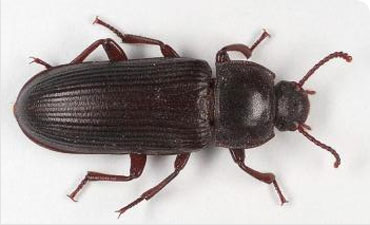Mealworm beetle
The mealworm is the larval stage, or grub, of the beetle Tenebrio molitor. Mealworms are commonly sold as pet food and specimens found are often petshop escapees.
Mealworm beetle
Tenebrio molitor
Identification
The adult beetles are dark brown to almost black in colour and range in length between 12 and 17.5mm. When viewed from above, the head, thorax and wing-cases are smooth and shiny. The mealworms, when fully grown, are cylindrical, smooth and reddish-brown in colour. They can reach a length of up to 40mm. In common with most beetle larvae, six very short legs are situated on the first three segments behind the head.
Distribution
Tenebrio molitor is a cosmopolitan species and is found all over the UK. It is occasionally found in people's houses but rarely in large numbers.
Behaviour
Wandering adult beetles have a habit of flying after dark and may be attracted to lights through an open window.
Life cycle
There are four stages in the life cycle, egg, larva, pupa and adult. Developmental times vary according to differing environmental factors, such as dietary quality, temperature and moisture availability. The best temperatures for development are between 25 and 27°C but eggs can be laid at the lower limit of 14°C.
Under normal conditions in the UK only one generation is produced per year but if higher, more favourable, temperatures exist then development is more rapid and two generations may emerge. Breeding is not possible at temperatures consistently above 30°C.
Living with humans
The species does not damage stored food products as it only develops slowly, and it is not a threat to human health. The larval stages are not known to damage wood either but the beetle is a minor pest of cereals and other grain products.
The best way to effectively eradicate the beetles is to remove and destroy the food source of the larvae. Household infestations often originate from birds' nests or associated debris in roof spaces or attics.
Any pests that might be providing food-material in the form of droppings, nesting debris, corpses etc. should be removed and their locations cleaned. Even access to potential nest sites in roof spaces should be blocked to prevent future use because birds often drop bread and other food down chimneys which attracts beetles to rooms without any apparent food source.
Providing that all potential food sources are sealed, infestations are unlikely to persist under normal conditions of hygiene. Any stray wandering adults will be deprived of the food needed to develop the next generation.
Toolbox

Last year nearly 100,000 specimens were loaned to scientific institutions and researchers worldwide.

